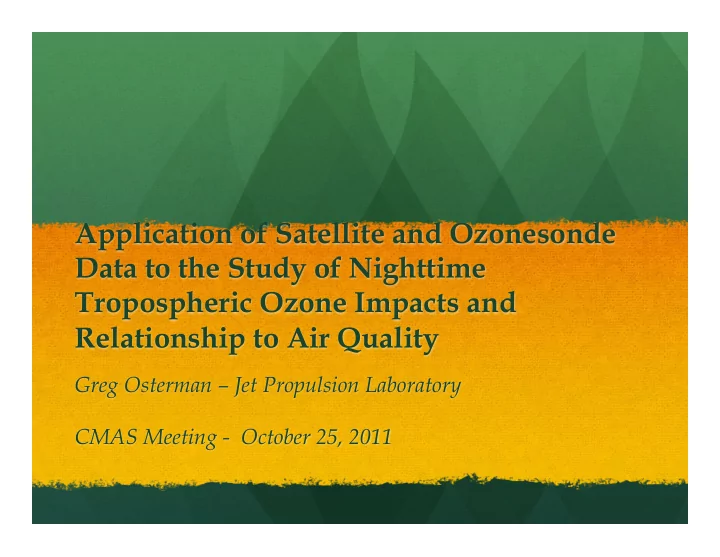

Application of Satellite and Ozonesonde Data to the Study of Nighttime Tropospheric Ozone Impacts and Relationship to Air Quality Greg Osterman – Jet Propulsion Laboratory CMAS Meeting - October 25, 2011
Investigators AURA 2010 Proposal Annmarie Eldering (PI, JPL), Jessica Neu (JPL) Jeff McQueen, Youhua Tang (NOAA/NWS) Rob Pinder (EPA)
Project Objectives Characterize nighttime ozone aloft using satellite data and ozonesondes Evaluate the ability of the EPA CMAQ and NOAA National Air Quality Forecast Capability (NAQFC) to capture nighttime ozone aloft and possible relationship to air quality events Evaluation of ozone, carbon monoxide and other key fields in air quality models in the middle/lower troposphere using satellite data Case Studies: Analyze a set of air quality events and determine if there is a relationship to nighttime ozone aloft !
Data and Models Models: NAQFC Forecast EPA CMAQ 4.7.1 Time Periods – July/August 2006, 2008, 2009 Evaluation Data Sets: Satellite data from TES (O3, CO, TATM, H2O), and OMI (O3, NO2) Ozonesondes Surface monitors
TES
TES on EOS-Aura Launched 2004.07.15
TES on EOS-Aura Launched 2004.07.15 TES Measures in Nadir Mode (~01:30 AM/PM Local Time): � Ozone � Carbon Monoxide � Water Vapor and HDO � Ammonia � Methane and Carbon Dioxide � Surface Temperature (Sea Surface Temperature)
TES Nadir Coverage TES Footprint 5 x 8 km Global Survey footprints 180 km apart Every 2 days … ~767 and counting Step & Stare footprints 45 km apart Special observation Transect footprints 12 km apart Special observation
Elevated CO and O3 over SE Texas observed from TES on Aug 23, 2006 TES CO TES O3 � TES resolves peaks in middle and lower tropospheric O3 and CO over East Texas � Used to identify high ozone in middle troposphere � Assimilated (along with OMI and MLS data) into RAQMS
AIRS & TES CO – August 23, 2006
Measurement Sensitivity ! !
New: TES + OMI
Measurement Sensitivity
Air Quality Model Evaluation using TES
Model Evaluation using TES Tropospheric O3 Looked at mean of TES profiles for July in three areas: � Northern CA/NV and Southern Oregon � Southern CA Desert � Pacific off CA Coast
Model Evaluation using TES Tropospheric O3 Must take into account vertical sensitivity of TES measurements when comparing profiles to the model
Evaluation: Ocean � TES Step & Stare observation July 18, 2006 � TES data used with models can provide information on transport of data across the Pacific
Ocean
Ocean � TES shows lower tropospheric ozone than the model in the lower troposphere (5-15 ppb) � Good comparison in the upper troposphere
Evaluation: Northern California TES shows reasonable comparison with model throughout the troposphere Surface monitor data higher than CMAQ for month at Lassen and Yreka
Evaluation: Southern California Desert TES shows higher tropospheric ozone than the model in the lower troposphere (15-20 ppb) Good comparison in the upper troposphere Surface monitor data higher than CMAQ for month at Death Valley, Palm Springs and Joshua Tree
Evaluation of CAMx Ozone in Free Troposphere Preliminary Result – CAMx model higher than TES in lower troposphere
TES Observations of Nighttime Ozone
TES Observations of Nighttime Ozone � June 2009 – Transect Special Observations
TES Observations of Nighttime Ozone
TES Observations of Nighttime Ozone O3 in the Houston area on the morning of June 7 was in the range of 30-40.
Wrap Up Just getting started … Model outputs received – July and August 2006 from EPA and NOAA/NWS Beginning day time comparisons with TES and ozonesondes Systematic comparisons to models (daytime and nighttime) Acknowledgements Aura 2010 Project Investigators Dejian Fu and Entire TES team Thank you!
Recommend
More recommend